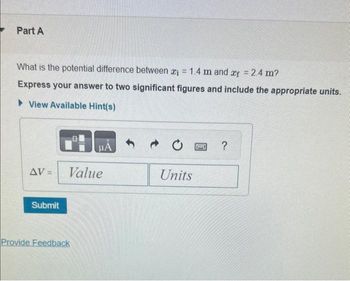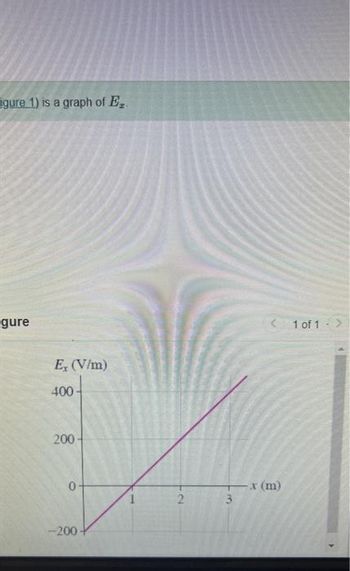Question

Transcribed Image Text:Part A
What is the potential difference between ₁ = 1.4 m and af = 2.4 m?
Express your answer to two significant figures and include the appropriate units.
View Available Hint(s)
AV-
Submit
HA
Value
Provide Feedback
Units
P
?

Transcribed Image Text:gure 1) is a graph of E
gure
Ex (V/m)
400-
200
-200-
2
3
-x (m)
1 of 1
Expert Solution
This question has been solved!
Explore an expertly crafted, step-by-step solution for a thorough understanding of key concepts.
This is a popular solution
Trending nowThis is a popular solution!
Step by stepSolved in 2 steps with 2 images

Knowledge Booster
Similar questions
- ER Find the total capacitance of the combination of capacitors shown in the figure below. (C, = 30.5 µF, C, = 5.66 µF. Enter your answer tó three decimal places.) 0.300 µFarrow_forwardPlease help solve parts b) and c) only. The correct answer for each part : Part a): 286 Ohm Part b): 6.39 mA Part c): for this one use capacitor operation d = 1.45 mm so solution is 668 V/m Thank you!arrow_forward= 6.44 0, and R, = 2.48 2. 1. Find the potential difference between point a and point b for the situation shown below. Here &, = 12.0 V, 8, = 7.77 V and R, = 4.13 0, R, R1 R2 R3 b. V,- V, = ww wwarrow_forward
- Three capacitors are connected as shown, where C = 0.035 F. Part A) What is the equivalent capacitance, in farads, between points A and B? Part B)If the capacitors are charged with a ΔV = 10 V source, how much energy will the circuit store, in joules?arrow_forwardQuestion 3 Look at the arrangement of the capacitors below. A) Find the equivalent capacitance of the arrangement. B) What is the voltage across each capacitor? V₁ = V₂ = V3 = V4= C) What is the magnitude of the charge stored on each capacitor's plates? Q₁ = Q₂ = A 4 F 6 F 4 F B Now imagine that a dielectric with dielectric constant k = 5.0000 is placed inside the upper left capacitor. D) Find the new equivalent capacitance of this arrangement. AVAB 10 volts still A k=5.0000 6F 6 F B = 4F 4F AV₁ = 10 volts ABarrow_forwardTo recharge a 10 V battery, a battery charger must move 3.0 105 C of charge from the negative terminal to the positive terminal. How much work is done by the charger? Express your answer in joules. Jarrow_forward
arrow_back_ios
arrow_forward_ios